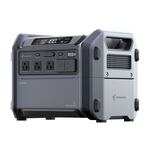First trial free, cancel within 14 days to avoid $129/year.
Power station with 2200w AC output to power almost any household appliance.
A definite cut above the cheapies with IP56 waterproofing, UPS, 4000+ cycles, expandable to 5kw, low fan noise silent up to 700W draw, good smart app features, fast AC charge under one hour, etc.
**** 2000wh model also available for $1499 First members, but odd pricing, cheaper to buy 2x1000wh models ****
I bought the 2000A model on special in Feb for $1249 as extra storage/inverter for an older campervan and it has been brilliant. The 2000A is just the 1000A with an addon 1kW battery pack. The 1000A is the better buy, more portable with a big 2200W inverter output (4400w max) for such a small package. Overseas model shown but advertised as official Australian stock, which comes with Aust. sockets and faster AC charging on 240V (not 110V),



Its 240v with AU plugs, right?
Specs say Input: 120V and show US plugs but I guess its a copy paste error?